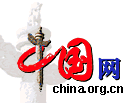CEOs of America Tricon Global Restaurants, the group that owns KFC and Pizza Hut, promotes Traditional Peking Chicken Roll at a KFC restaurant in Shanghai.
At present, there are more than 1,000 KFC restaurants in China, and they are increasing at annual rate of 200. A new KFC restaurant opens every other day. Western counterpart McDonald's also continues to expand its premises.
Having arrived on the mainland in the early 1990s, McDonald's has more than 600 restaurants in nearly 100 cities. Although there have been fewer golden arches in America, its native country, in the past two years, China's McDonald's have grown at a rate of 100 restaurants per year.
The total income of fast food restaurants in China now stands at 180 billion yuan RMB, and KFC and McDonald's account for eight percent. What kind of magic has brought them such success in China? How do they sustain growth rates? Their standardized business operation apart, the key is excellent inter-cultural management.
Western Fast Food — Chinese Style
Alluring the captious customers is a hurdle every foreign fast food restaurant must clear. The novelty of these fast food restaurants initially won many customers. Although cheap and commonplace in America, at the time the Chinese government's opening-up policy was newly enacted, fast food was exotically foreign enough to whet Chinese people's curiosity about the outside world. Managers took advantage of this by charging the relatively high prices of 10 yuan for a hamburger, and 5 yuan for a Coke.
By the mid-1990s, there were 100 fast food restaurants around Beijing; the convenience, efficient service, comfortable environment, pleasing music and jovial atmosphere garnered fans. Office workers enjoyed grabbing a quick bite on their way to work, and friends enjoyed relaxing over a Coke. However, certain eagle-eyed managers noticed that some people never dropped in when they passed by. Some customers complained that fast food was not as good as their Chinese cuisine, and that it lacked variety. McDonald's and KFC restaurants were almost empty during the traditional celebrations of Spring Festival and Mid-autumn Festival, while Chinese restaurants were heaved and bustled.
The reason? Cultural differences. Fast food restaurants like KFC and McDonald's are distinct American brands. Differences between China and US politics, economics, social development and ideology became obstacles to international enterprises operating in China. Corporate culture could not be understood or accepted here, especially in the restaurant field, where culture plays a crucial role.
McDonald's at full sail on the Huangpu River.
So the solution was to adapt: when in Rome, do as the Romans. Deep-rooted in the Chinese consciousness is the traditional culture of food and drink that features color, fragrance, flavor and variety. Fast food simply does not compare. Now that curiosity had faded, people returned to their own more extensive cuisine. Under such circumstances, the only way out was to combine the two different cultures. Fast food restaurants have been learning to absorb elements of Chinese culture.
Since the summer of 2001, KFC has introduced many Chinese items onto their menus. Preserved Sichuan Pickle and Shredded Pork Soup was one of the first. Consumers felt their traditions were being respected when they could taste Chinese cuisine at a foreign restaurant. The soup proved a success, and Mushroom Rice, Tomato and Egg Soup, and Traditional Peking Chicken Roll were soon added to the menu. KFC also serves packets of Happy French Fry Shakes that contain beef, orange and Uygur barbecue spices.
Not content to lag behind, McDonald's Vegetable and Seafood Soup and Corn Soup were introduced, and the company worked to modify the restaurants' design. During the 2004 Spring Festival, McDonald's on Beijing's Wangfujing Street attracted many people with a traditional Chinese look, decorating their interiors with paper-cuts of the Chinese character Fu (Happiness), magpies and twin fishes, all auspicious symbols.
Inter-cultural Management Mode
KFC and McDonald's have absorbed the Chinese cultural elements of showing respect, recognition, understanding, assimilation and amalgamation, while maintaining the substance of the Western culture of efficiency, freedom, democracy, equality and humanity. This inter-cultural management mode, with American business culture at the core, supplemented by Chinese traditional culture, provides reference for international enterprises which need to adjust, enrich and reconstruct their corporate culture to enhance local market flexibility.
There are, however, certain conditions essential to inter-cultural management mode. On the objective side, there must be similarities in environment in order for the two cultures to connect and synchronize. KFC and McDonald's embody an accommodation of the fast tempo of modern life: a product of development and a market economy. Their resultant speed and efficiency are only meaningful in countries with a market economy. China's rapid economic development offered the environmental conditions corresponding to fast food culture. Services offered by fast food chains express their full respect for freedom, an American value, as well as the psychological statement of Chinese open-mindedness that yearns to understand and experience the Western lifestyle. Two cultures proactively crashed, connected, and assimilated. KFC and McDonald's use the localization strategy to re-express American business culture, with profound traditional Chinese cultural emblems, catering to local customs on the basis of standardized management.
(China Daily June 1, 2004)

